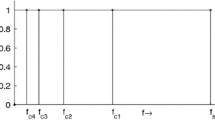Abstract
Conventional methods of spectral analysis are based on mathematical or numerical algorithms applied to digitized signals. This paper discusses the applicability of the phase-locked loop (PLL) approach for tracking electroencephalogram (EEG) rhythmic bands (delta, theta, alpha, or beta). The use of the PLL for frequency tracking should also aid the development of online EEG interpretation and screening based on frequency characteristics when the PLL is realized by hardware. As a result, two factors in the applicability of the PLL are: (1) translation of the EEG spectrum to a higher-frequency band by a single-sideband (SSB) modulation scheme, and (2) the narrowband spectral feature of the EEG—a small difference between two major frequencies. The PLL output is further quantized according to the EEG rhythmic bands. Our analysis shows that the integrated system is capable of tracking the EEG rhythmic patterns.
Similar content being viewed by others
References
J. T. Allen and L. R. Rabiner, A unified approach to short-time Fourier analysis and synthesis,Proc. IEEE, 65, 1558–1564, 1977.
C. Andrew and G. Pfurtscheller, Event-related coherence as a tool for studying dynamic interaction of brain regions,Electroenceph. Clin. Neurophysiol., 98, 144–148, 1996.
M. Arnold, W. H. R. Miltner, H. Witte, R. Bauer, and C. Braun, Adaptive AR modeling of nonstationary time series by means of Kalman filtering,IEEE Trans. Biomed. Eng., 45 (5), 553–562, 1998.
R. Broughton, A phase locked loop device for automatic detection of sleep spindles and stage 2,Electroenceph. Clin. Neurophysiol, 44 (5), 677–680, 1978.
D. Burger, Analysis of electrophysiological signals: A comparative study of two algorithms,Comp. Biomed. Res., 13, 73–86, 1980.
R. Cooper, J. W. Osselton, and J. C. Shaw,EEG Technology, 3rd ed., Butterworth, Woburn, MA, 1980.
M. S. El-Hennawey, High resolution frequency tracking system using the maximum entropy method,Internat. J. Electron., 77 (2), 139–147, 1994.
P. J. Franasczuk, K. J. Blinowska, and M. Kowalczk, The application of parametric multichannel spectral estimates in the study of electrical brain activity,Biol. Cybern., 51, 239–247, 1985.
F. M. Gardner,Phaselock Techniques, Wiley, New York, 1979.
V. Goel, A. M. Brambrink, A. Baykal, R. C. Koehler, D. F. Hanley, and N. V. Thakor, Dominant frequency analysis of EEG reveals brain's response during injury and recovery,IEEE Trans. Biomed. Eng., 43 (11), 1083–1092, 1996.
R. Hebert and D. Lehmann, Theta bursts: An EEG pattern in normal subjects practicing the transcendental meditation technique,Electroenceph. Clin. Neurophysiol., 42, 397–405, 1977.
R. Hoffmann and D. Jeakins, Computer quantification of delta activity in sleep EEG,Comp. Biomed. Res., 20, 366–372, 1987.
G. Hsieh and J. C. Hung, Phase-locked loop techniques—A survey,IEEE Trans. Indust. Electron., 43 (6), 609–615, Dec. 1996.
M. W. Johns, E. B. Stear, and J. Hanley, Tracking the dominant frequency of the EEG by phase-locked loop demodulation,Electroenceph. Clin. Neurophysiol., 37, 414–416, 1974.
T.-P. Jung, S. Makeig, M. Stensmo, and T. J. Sejnowski, Estimating alertness from the EEG power spectrum,IEEE Trans. Biomed. Eng., 44 (1), 60–69, 1997.
T. Kalayci and Ö. Özdamar, Wavelet preprocessing for automated neural network detection of EEG spikes,IEEE Eng. Med., Biol. Mag. 14, 160–166, 1995.
F. Matsuo, Expanded head surface EEG electrode array: An application to display the voltage topography of focal epileptiform discharges of mesiotemporal origin.J. Clin. Neurophysiol., 8 (4), 442–451, 1991.
T. Nakagawa and T. Tsukahara, A low phase noise C-band frequency synthesizer using a new fractional-N PLL with programmable fractionality,IEEE Trans. Microwave Theory Tech., 44 (2), 344–346, 1996.
S. H. Park, J. C. Principe, and J. R. Smith, TDAT—Time domain analysis tool for EEG analysis,IEEE Trans. Biomed. Eng., 37, 803–811, 1990.
M. E. Rizkalla, H. Gundrum, and H. Michel, Design of a fractional phase-locked loop frequency synthesizer,IEE Proceedings-A, 138 (6), 295–299, 1991.
D. L. Sherman, Y. C. Tsai, L. A. Rossell, M. A. Mirski, and N. V. Thakor, Spectral analysis of a thalamus-to-cortex seizure pathway,IEEE Trans. Biomed. Eng., 44 (8), 657–664, 1997
F. G. Stremler,Introduction to Communication Systems, 3rd ed., Chapter 5, 255–262, Addison-Wesley, Reading, MA, 1990.
W. J. Williams, H. P. Zaveri, and J. C. Sackellares, Time-frequency analysis of electrophysiology signals in epilepsy,IEEE Eng. Med., Biol. Mag., 14, 123–143, 1995.
D. H. Wolaver,Phase-Locked Loop Circuit Design, Prentice-Hall, Englewood Cliffs, NJ, 1991.
Author information
Authors and Affiliations
Additional information
This work was supported by the National Science Council of Taiwan, Republic of China, under grant NSC87-2213-E-009-128.
Rights and permissions
About this article
Cite this article
Lo, PC., Lee, YY. Applicability of phase-locked loop to tracking the rhythmic activity in EEGS. Circuits Systems and Signal Process 19, 171–186 (2000). https://doi.org/10.1007/BF01204572
Received:
Revised:
Issue Date:
DOI: https://doi.org/10.1007/BF01204572




